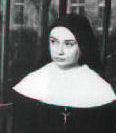Appendix 4: Outfitting the Pope: Threads, Bling, and Rides
The Pallium

The pallium is always worn by the pope when celebrating mass. The pope can confer the pallium on any archbishop. The designation brings prestige but no special authority.
Capes, Cassocks, and the Like
Many popes have worn capes. The mozzetta, which dates from the middle ages, comes in several styles. The pope’s is white between Easter and Pentecost. The summer mozzetta is usually silk. The winter one is velvet or some similarly thick material and is trimmed in ermine. Pope John Paul II never wore the winter one, but Benedict XVI brought it back. The mozzetta at one time had a vestigial hood that was never used. Pope Paul VI made a strong fashion statement by eliminating the hood altogether, but the buttons have endured. The mozzetta is meant to be a practical garment; it cannot be used in liturgical functions. Beneath the mozzetta is the rochet (ROCH et), a white linen garment trimmed with lace that goes all the way to the pope’s knees. The sleeves are tight-fitting, unlike the surplus worn by altar boys and the like. It is never used in the administration of the sacraments. It was called a camisia until the late middle ages. Every priest wears a cassock, the familiar long black garment that is buttoned in front. The pope’s is generally white.On top of all of this the pope sometimes wears a white cape called a tabarro.
The firm of Annibale Gammarelli has been supplying the pope with his outfits since 1792. Pope Benedict evidently did not like the feel of some of their garments and farmed out some of his tailoring to Raniero Manicelli. This news shocked Italy.
Footgear
Over the centuries the pope’s footwear evolved from sandals into flimsy silk slippers. Their red color was a symbolic tribute to the martyrs. Crosses made of precious stones were sewn onto the tops. The submissive act of kissing the pope’s feet could therefore be deemed an act of Christian devotion to the cross. The custom[2] allegedly arose in the time of Pope Leo the Great. Some recent popes have worn leather shoes that resembled the traditional slippers. Pope John Paul II shockingly favored comfortable brogans. His successor, Pope Benedict, has caused quite a stir in his red loafers, allegedly made by Prada. If the devil can wear Prada, why not the pope?The pope’s stockings are called caligae. They were once known as compagi. There is nothing special about them.
The Pope’s Lids
Trailing down from the miter are two long flaps called infulae. The infulae actually preceded the miter. They were originally of one piece – a long ribbon worn as a headband with a knot in the back. The way that two dangling pieces fell on the wearer’s back was reminiscent of the Rambo look.
Popes are often seen wearing a little white beanie, called a zucchetto (or pileolus). It is always worn beneath the miter, but it can also be worn alone. Cardinals wear red zucchetti. Those of the bishops are violet. The zucchetto has been around since at least the thirteenth century. The Italian word means a small pumpkin or gourd. Since the 1100’s the pope’s favorite winter headgear has been the camauro. It resembles a Red Grange-era football helmet with ermine fur along the edges to provides warmth and ornamentation. Almost all popes portrayed in the famous Renaissance paintings wear red camauros. Pope John XXIII wore one occasionally. The two John Paul’s eschewed them, but Pope Benedict XVI has been photographed in one. Only the pope is allowed to wear the camauro, but if he is ever spotted in it, he might inspire Mr. Blackwell to make a list for men. All clergy except the pope wear a biretta, the square cap with fins on top worn by Barry Fitzgerald in Going My Way. One fin goes from back to front. One goes halfway from right to left. Usually a little tuft sits on top in the middle.The pope’s coolest lid is the cappello romano, a felt or beaver-fur hat featuring a broad round brim.[4] The head sits in a little pill box or derby in the middle. The pope’s is red with gold cords. It is sometimes confused with the galero, a huge red hat once worn by cardinals[5] that now has only ceremonial functions.
The Tiara
For centuries the tiara was the quintessential papal headgear, and it had the most material and symbolic value. It was probably introduced in the ninth century, during which the papacy assumed rule over territories donated by the Frankish kings. The kings had crowns, so the pope got one as well. A row of jewels was almost immediately added. Pope Boniface VIII added a second row of jewels to the tiara to emphasize that, unlike the wearers of ordinary crowns, the pope had both spiritual and temporal dominion. Pope Benedict XII added a third row of jewels to suggest that … well, that the pope could wear a crown with three rows of jewels if he wanted to. He also added two cloth strips (called lappets) that hang down from the back.In the good old days the papal investiture ceremony culminated in the placing of the tiara on the pope’s head. The last pope so crowned (with a jewel-free tiara) was Paul VI. At the end of Vatican II he placed his tiara symbolically on the altar of St. Peter’s Basilica, and donated its value – not the piece itself[6] – to the poor. His successor, John Paul I, chose a simpler ceremony with no tiara, and that choice was echoed by subsequent pontiffs.
Many tiaras have been created over the ages. Several popes ordered their own tiaras, some more than one. At least twenty-two are extant, all less than five hundred years old. In 1527 Pope Clement VII melted down all the tiaras and papal regalia to raise the ransom of 400,000 ducats demanded by the imperial force occupying Rome. The cheesiest tiara was the papier-mâché one used by Pope Pius VII. His predecessor’s tiaras had been seized by Napoleon, and no one stepped forth to pony up the cash for a new one.
The Ring of the Fisherman
The most famous papal gewgaw is the gold Ring of the Fisherman, the pescatorio. Its surface contains a bas relief of a fisherman. Up until the 1840’s it was used to seal papal documents. To prevent the back-dating of documents a dead pope’s ring is officially crushed. Recent popes have returned to the custom of allowing people to kiss their rings rather than their feet.
The Pectoral Cross
Rules governing the Pectorale, the cross worn around the neck by the pope and other prelates, are not very strict. The colors and composition are not prescribed, but the cross itself is usually made of precious metal and contains a relic. Anyone can wear a pectoral cross, but it is usually kept beneath the outermost garments by anyone below the rank of bishop. Pope Benedict XVI’s pectoral crosses range from simple ones for daywear to an eye-catcher with emeralds for formal occasions. A silver one was a gift from the Archbishop of Canterbury.
Weaponry
St. Peter and Pope Julius II were known for their swords, but centuries have passed since any pope took up arms. If an early pope battled an antipope, a cockatrice, or some other malefactor, he could use his crosier, the shepherd’s staff. The pope’s scepter was first mentioned in 964 when Pope Benedict V was deposed by a synod. The emperor’s pope, Leo VIII, broke Benedict’s staff over his knee. Both men are considered legitimate popes. The papal crosier was set aside by Pope Innocent III in favor of a ferula, a knobbed staff. Pope Paul VI brought back the pastoral staff, with the traditional crook replaced by a cross. Pope John Paul II changed the design.
The Pope’s Backside
The “throne of St. Peter,” generally refers to the baroque Bernini monstrosity housed in the Basilica of St. Peter. The gilt bronze throne was crafted around a wooden chair known as the Cathedra Petri, which had been used by popes for centuries. The chair did not, however, date all the way back to St. Peter himself. In fact, carbon dating placed it in the ninth century. Several other chairs were previously called the Cathedra Petri.
Another famous papal chair was the sella stercoraria, also known as the chaise percée or Porphyry Chair, which featured a keyhole-shaped opening in the middle. The legend persists that its purpose was to allow verification of the gender of the pope – by hand! The chair was part of the papal coronation for many years. The man elected pope would sit on it. The cardinals would then lift him up. No pope has suffered this since Leo X. Pope Pius VII gave the last chair to King Louis XVIII in appreciation for returning many works of art confiscated by Napoleon. That chair is reportedly in the Louvre.[7] Another one is reportedly in the Vatican Museum and/or St. John’s Lateran.Pope My Ride
For centuries the pope’s ride was a white mare, or palfrey. In the “Donation of Constantine” the emperor performed the function of strator, in which he led the pope’s horse by the bridle. Many emperors and kings subsequently performed this ceremony in deference to the papacy. The king of Naples provided the horse until the late eighteenth century.
The sedia gestatoria was the pope’s sedan chair. Before the second half of the twentieth century, the pope’s feet seldom touched the earth on ceremonial occasions. The Holy Father was ported around in the chair by a dozen or more bearers. While he was in the huge vehicle, he was cooled by ceremonial fans made of ostrich feathers called flabella. The pope now travels by plane, helicopter, and automobile. His ground-based vehicle has been dubbed the popemobile. It is disappointing to discover that there is no official popemobile;[8] the popes have used many different autos, some of which are on display in the Vatican Museums. The most bizarre-looking one allowed Pope John Paul II to stand up in a bulletproof box. The security measures were implemented after he was shot at short range in 1981. The popemobile does not travel with the pope. The hosting country provides him with a vehicle that allows him to be safely visible.[1] The Catholic Encyclopedia, op. cit., Vol. XI, p. 427.
[2] Odor Eaters were invented in the early 1970’s by Herbert Lapidus. It is difficult to discover whether most popes engaged in regular bathing or depended on the annual foot-washing of the Maundy Thursday ceremonies. Most historians have neglected this aspect of papal behavior. Actually, all of them have.
[3] Rita A. Thyron, Upon This Rock: Protocol, Procedures and Liturgical Preparation for use upon the Death of a Pope and the Election of His Successor, Office of Worship, Diocese of Lansing, p. 41.
[4] Fr. Guido Sarducci’s original hat resembled a black capello romano, but the brim was too floppy.
[5] When someone talks about a new cardinal getting his red hat, he/she is referring to the galero.
[6] The tiara was donated to of the National Shrine of the Immaculate Conception in Washington, D.C. by the Apostolic Delegate to the United States in 1968.
[7] I visited the Louvre in the summer of 2009. The Atlas lists a “Chaise percée” in Room 42 of the first floor of the Sully wing. The wing was closed when I was there, but it is obvious from the photo in the catalog that the item is a commode, not a sella stercoraria.
[8] There is no popecave either.
 | |
 | |
Bankable Bar Bets
$ For centuries popes were invested while sitting on what looked like a toilet seat. One cardinal allegedly reached beneath the pope’s vestments to assure his masculinity.
$ There is no official popemobile.


















